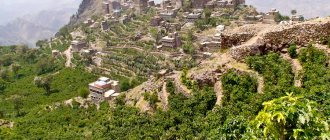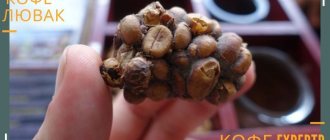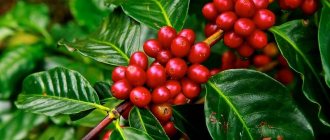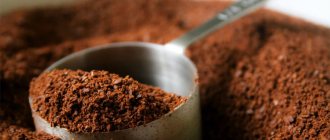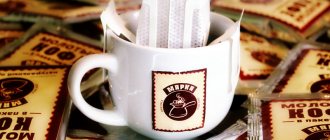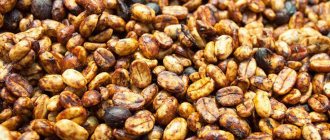Landing
The coffee bean is the seed for planting the coffee tree. Dried, roasted and ground, it is used to brew coffee. Unprocessed grain can be used for planting.
Coffee beans are planted in large tanks and left in dark rooms. The sprouts are watered regularly and kept away from sunlight. When they become strong enough, they are transplanted to plantations. This is usually done during the rainy season so that there is enough moisture in the soil to support the roots.
Harvesting
It will take three to four years for the tree to begin bearing fruit. Unripe coffee berries are green in color. Depending on the variety, they turn bright or dark red when ripe and ready for harvest. They ripen faster in low mountainous areas and at high temperatures. Usually the crop is harvested once a year. In countries where flowering occurs twice a year, such as Colombia and Kenya, coffee is harvested twice a year.
Coffees harvested early or late in the season have a weak flavor, while mid-season coffees harvest bold flavor profiles. For this reason, the best roasters purchase their coffee mid-season.
In most countries, manual labor is used to ensure the ripeness of the berries. The fruits ripen at different times and it may take up to three pickings to fully harvest the entire crop. In countries with relatively flat landscapes, such as Brazil, this process takes place using machinery, which certainly makes the job easier.
Harvesting is done in one of two ways:
- Stripping - all the berries are removed from the branch at the same time by hand or using equipment.
- Picking - only ripe berries are removed and only by hand. Farmers walk around the trees every 8-10 days, choosing only the ripest berries. Due to the fact that this method is labor-intensive and more expensive than stripping, it is used primarily for collecting high-quality Arabica beans.
A good harvester will collect 45-90 kilograms of coffee cherries per day, which can then be used to produce only 10-20 kilograms of coffee! The number of berries collected by each picker per day is weighed, and labor is paid based on the results.
How coffee is made. From harvesting to roasting
Timing and method of harvesting
Harvest times occur at different times in different parts of the world.
In Brazil, it is limited to the time frame from April to September, on the plantations of Costa Rica - from September to January, Ethiopian coffee is harvested in October-December, and Malawian coffee - from December to February. The coffee year begins on October 1 and ends on September 30. Coffee pickers much more often resort to “stripping” - a method that does not leave a single berry on the branches. Fruits of varying degrees of maturity are sent to a processing station (“wet mill”), where they are sorted. Mechanized coffee harvesting (using specialized combines) is not always possible due to the fact that coffee plantations are often located on too steep mountain slopes: agricultural machines simply cannot pass there. Coffee harvesting is most mechanized on plantations in Brazil. When “stripping” and mechanized picking, the collection of both unripe and overripe fruits is inevitable.
Video: How is coffee made?
The harvested crop should still be consolidated. This is a very important stage. One should not naively believe that coffee producers obtain raw materials directly from the plantations or purchase them at the coffee exchange. Such cases are so rare that they can be counted on one hand. Export of coffee from the country of origin occurs in a different way. For example, in a coffee-growing country, there is a farmer whose plantation produces up to ten tons of coffee beans per year. Where can he put the harvest? He simply cannot process coffee on his own, since in the coffee business there is a sharply negative assessment of “home-grown” processing. African coffee that has undergone “washed” processing carried out by the efforts of the farmer himself is called “washed”. Coffee beans processed at a specialized processing station are labeled “fully washed” and have a higher price category.
Coffee bean processing
Before being exported, the coffee usually goes to a processing station. Nowadays there are two types of such stations:
- "wet mill" (wet processing point);
- “dry mill” (dry processing point), although there is still a lot of confusion in the terminology.
In fact, everything is very simple: coffee beans are subjected to either washed or natural (dry) processing. Confusion arises when translating terms into Russian. In English terminology, processed coffee beans are referred to either by the term “dry processed” (dry or natural processing) or “wet processed” (wet processing). As a result of natural processing, natural coffee is obtained, and wet processing gives the consumer washed coffee. In the context of translation into Russian, it turns out that “natural” coffee is contrasted with “washed” coffee.
Abstracting from linguistic subtleties, it is important to understand the following: dry (natural) processing of coffee fruits that have not been peeled comes down to their elementary drying in the sun. Wet processing requires the presence of water for sorting and processing coffee fruits. Let's look at each of these methods in more detail.
In coffee growing regions, two methods of fruit processing are used: natural (or dry) and wet (or wet). During dry processing, coffee fruits are dried either directly on the soil or on special clay and concrete platforms. Fruits that have undergone dry processing acquire a rich and strong taste, high intensity and pronounced sweetness. However, they may develop a specific taste that not everyone likes. Grains dried on the ground often develop a very unpleasant defect - a characteristic earthy taste.
Despite the richness and brightness of the taste of dry-processed coffee beans, washed fruits are valued higher in all corners of the globe. There is a simple explanation for this. The choice of dry processing is sometimes dictated not by the desire to obtain a rich taste. This method is often chosen by farmers who are unable to transfer their coffee to the wet processing point on time. In this case, the desire for product quality is often not up to par. A truly high-quality product, in no way inferior to washed coffee, can be made only if all the technological rules of natural processing are followed. Ideal conditions for dry processing of coffee beans exist in regions where the harvest coincides with a long dry period, eliminating the possibility of precipitation. Such climatic conditions exist in Brazil, Indonesia, Yemen, and Ethiopia. The main technological nuance of natural drying is the long-term contact of coffee beans with the extremely sweet tissues of the skin that envelops them.
Video: Film about coffee
During the wet processing process, the coffee fruits are depulped, completely freed from the skin, after which they are sent to huge tanks filled with water. In them, the fruits are aged until the gluten is completely removed. When immersed in water, some of the inferior grains, which have a very low density and are called “floats,” immediately float up. All floats should be removed immediately as they will turn into black coals in the fryer. Unripe fruits are also sorted using special devices. At the end of wet processing, all grains are dried: either in the sun (as with natural processing) or in mechanical dryers.
Compared to fruits subjected to natural drying, the taste of grains that have undergone wet processing is more balanced and soft. Wet processing, as opposed to dry processing, enhances the acidity of the coffee beans rather than their sweetness. Taking this feature into account, wet processing is used in regions that grow coffee varieties that have their own unique acidity. Countries that do not have the opportunity to subject the beans to long-term natural drying are also forced to resort to wet processing of coffee, since the harvest in them coincides with the rainy season. Thus, most of the world's coffee is wet processed, and the ability to choose between beans that have undergone different processing methods only enriches the flavor palette of everyone's favorite drink.
Logistics and transportation of coffee
The notorious farmer, whose harvest amounted to ten tons of coffee fruits, has two options: either hand them over to a wet processing station, or engage in independent natural processing. With any option for processing the crop, the farmer will be forced to sell it to the exporter due to the impossibility of organizing the entire logistics chain that ensures the delivery of the finished product from his plantation to the port and from there to the recipient of the cargo. Most farmers, who have no idea about the structure of the banking system, are not able to pay the recipient of their products. The exporter, acting as an intermediary, sells the coffee beans to an exchange trader (trader), who then sells them either to a reputable roaster who independently imports coffee, or to a large company specializing in coffee imports. The shipment of coffee from the growing region is carried out by the exporter, and the international company guarantees the arrival of the valuable cargo at its destination.
Video: As it is. Coffee
Direct negotiations with coffee producers on plantations are carried out in very rare cases. This mainly concerns the vast Brazilian plantations, which have an excellent global reputation, as well as roasting companies that own their plantations in the place of cultivation. Direct purchases of microlots - very small (about two dozen bags) batches of coffee of the highest quality - are very rare. In the vast majority of cases, the purchase and transportation of coffee is carried out according to the scheme described above.
Processed grains are dried and poured into bags before export. To acquire the desired taste, producers (most often Brazilian) age the coffee in special silos.
From the places where it grows, coffee is exported in jute bags, the weight of which in Central American countries is 69 kg, in Colombia - 70 kg, in Brazil and the countries of the Asian and African regions - 60 kg. Expensive varieties of coffee are supplied in bags of arbitrary weight: the Galapagos standard is twenty-five kg, the Yemeni standard is twenty kg, New Caledonian coffee is packed in ten kg bags, and Jamaica Blue Mountain coffee beans are exported in barrels holding fifteen kg. Polypropylene can be used as a material for bags. To transport coffee, the exporter rents twenty-foot containers (holding at least twenty tons) from a shipping company and fills them with bags of green beans.
Coffee roasting
Coffee that arrives in the country of consumption and reaches the roaster is roasted on special machines - roasters. They are:
- gas and electric;
- automatic and manual;
- convector and drum.
Each of these machines roasts beans differently.
There is only one rule for roasting coffee: the darker it is, the less sourness becomes, but the bitterness, strength and richness of taste only increase. The coffee roasting profession is of extraordinary interest to a true connoisseur of this drink. The main difficulty with roasting is that during this process the behavior of not only different types of coffee, but also different roasting machines can be unpredictable.
In addition to constantly searching for a roasting method suitable for a particular type of coffee, the roaster must take into account the individual behavior of the roaster used. You cannot learn the art of coffee roasting from a book alone. It can only be acquired experimentally, necessarily taking into account the density of the grains (depending on the height of cultivation) and their taste parameters. Roasting should only be done in the region of consumption, as close as possible to the coffee consumers. In such a huge country as Russia, the roasting of beans intended for Muscovites should be done in Moscow, and for coffee lovers from Khabarovsk - in Khabarovsk itself. The reason is that coffee beans retain their intense taste and amazing aroma only during the first two weeks after roasting. Over the next eight weeks, the coffee gradually loses these characteristics, and its quality is rated “B.” After two months after roasting, the rating of the drink’s taste properties is reduced to “C”. Coffee that has been roasted for four months can simply be thrown away: its smell becomes rancid, which cannot but affect the taste.
One of the main components of the quality of coffee beans is the freshness of the roast, but it is in relation to this parameter that an incredible number of omissions occur. Despite the large number of Russian companies engaged in roasting coffee at the highest professional level, the freshness of roasted coffee lying on supermarket shelves is not always at the proper level.
To store coffee, it is best to use a bag with a valve (either foil or paper). It is advisable to drink it within two months after purchase. Coffee can be prepared by a person who has not undergone any special training, which cannot be said about preparing it using professional coffee machines. This should only be done by baristas - people who have completed a special training course. The profession of a barista is akin to art: in the hands of a true professional, even mediocre quality coffee can turn into a cup of delicious espresso, and an inexperienced specialist can ruin the best beans.
The secret of a good cup of coffee, therefore, consists of three components: the quality of the beans themselves, the professional level of the roaster and the art of the barista. The participation of a barista significantly complicates the consumer’s task of assessing the taste parameters of a favorite drink. Another nuance of high-quality coffee is the roasting date: the more time passes from its moment, the worse its taste.
Coffee making technologies change and improve every year. But harvesting traditions remain more conservative. But they still differ significantly in different countries. Let's try to figure out how coffee beans are collected.
Treatment
After harvesting, processing must begin as soon as possible to prevent spoilage of the berries. Depending on the country and local resources, coffee is most often processed in one of two ways:
- Drying is an ancient method of coffee processing, often used in countries with limited water resources. Freshly picked berries are placed in the sun. To prevent the berries from spoiling, they are turned over several times during the day, and covered at night and during rain to prevent them from getting wet. This process can continue for several weeks until the water content in the berries is reduced to 11%.
- Washed - begins with removing the pulp from the grain, so it is simply dried in its own shell, the so-called “parchment”. First, the freshly picked berries are sent for processing in special equipment, where the pulp is removed. Next, the grains are grouped by weight, passing through water streams. Light grains go up, and heavy grains go down. So, the grains pass through several of these sorting drums with water, where they are separated by size. After sorting, the grains are placed in large tanks of water. Various factors—bean quality, climate, and altitude—affect how long the grains remain in these tanks. As a rule, they remain there for 12-48 hours, after which the grains pass through water streams again and are sent for drying.
In fact, these are not all processing methods, but only the main ones. You can learn more about all types of processing from our separate article on this topic.
Collection of different varieties of coffee: specifics of the process
Experts count three botanical varieties of coffee: Arabica, Robusta and Liberica. Each of them has its own specificity, which is expressed, among other things, also in the methods and features of the collection process.
As for Robusta and Liberica coffee fruits, after ripening they remain on the trees for quite a long time. This is necessary so that they, as they say, “dry”, and subsequently it is easier not only to collect them, but also to pre-process them.
Such a widespread and considered the most valuable variety of coffee, like Arabica, is harvested in several stages. The fact is that the fruits of this botanical variety ripen unevenly on trees, and therefore the ripe ones are removed step by step, leaving the unripe ones to “reach condition.” In most cases, the interval between collection stages is about two weeks, and most often there are three of them: preliminary, main and late.
It is mainly thanks to the gradual process that it is possible to ensure that the grains are ultimately of exceptionally high quality. In this case, a lot depends, of course, on the level of qualifications of those people who are involved in harvesting coffee: experienced pickers remove only ripe beans, and not overripe or underripe ones.
Drying
If the beans have been processed using the washed type of processing, they must be dried until the moisture content does not exceed the same 11%. These grains are still covered with parchment. Drying is carried out either on large tables, where they are regularly turned over, or using equipment.
All the dried beans, called unhulled coffee beans, are taken to a warehouse in jute or sisal bags where they will await their turn for export.
Cleaning
Before sending grains for export, producers carry out final processing of the grains. It takes place in three stages:
- Removing parchment. The parchment is removed from washed grains, since everything else was removed during the processing stage. Dry processed grains are cleared of all dried pulp.
- Polishing. An optional process by which all remaining fine particles are removed from the grain. While polished grains are considered better than unpolished grains, in reality there is little difference between the two.
- Grading and sorting. Occurs based on size and weight. Grains are also graded for the presence of imperfections in color. To determine the size of the grains, they are passed through several measuring instruments. They are also sorted in special equipment with high pressure to separate heavy grains from light ones. Defective grains are selected manually or automatically. Those that do not meet quality criteria (unacceptable size or color, presence of insects inside, excessive fermentation) are discarded. In many countries, both manual labor and equipment are used for this sorting to ensure high quality grains.
Cupping
Cupping - quality and taste testing - is carried out several times in a room specially equipped for this.
First, the cupper evaluates the grains by appearance. Then the grains are roasted in a small laboratory roaster, immediately ground and poured with hot water at a strictly regulated temperature. The first thing a cupper begins to evaluate a drink with is the aroma.
Next, the cupper tastes the coffee in small portions, while trying to cover all taste buds.
Coffee is analyzed not only to determine characteristics and shortcomings, but also to create balanced blends and select the desired type of roast. Experienced cuppers can taste hundreds of different varieties a day and still feel the subtle differences between them.
How and from what instant coffee is made: production
Coffee comes in beans (or natural) and instant. About 50% of coffee beans are processed into instant coffee. It is prepared from 100% robusta, arabica and a combination of robusta and arabica. First, the coffee beans are roasted, then “allowed to rest” for 3-4 hours.
Then the grains are ground to a certain diameter - at least 0.5-1.1 mm and a strong stream of hot water is applied to them to wash out the carbohydrates from them. Cool, filter and thicken.
The resulting thick extract is dried using different methods:
- sprayed under hot air, obtaining the cheapest powdered coffee;
- by processing coffee powder with steam, granulated coffee is obtained;
- Freeze-drying produces freeze-dried coffee.
The last stage of coffee processing is aromatization: natural essential oils are added to expensive varieties, and flavorings are added to cheap varieties.
Roasting
Roasting turns green beans into the aromatic chocolate-colored beans that we are used to seeing in stores and coffee shops. Most roasters roast coffee at around 287°C. All this time, the roaster blades constantly mix the grains so that they do not ignite.
When the internal temperature of the beans reaches approximately 205°C, they turn brown and secrete kafeol, an oil contained in the beans themselves. The process is called "pyrolysis"; This is a kind of “heart” of roasting - it reveals the aroma and taste of the coffee we drink.
After roasting, the beans are immediately cooled with air or water. Roasting is usually performed by the importing country because freshly roasted beans need to reach consumers as quickly as possible.
There are 3 basic coffee roasts: light, medium and dark. Light and medium roasts best retain the true flavor of the beans, while dark roasts are bitter and contain the least caffeine.
Roasting coffee beans
A very important, if not the most important stage in coffee production is the process of roasting beans.
, thanks to which the whole bouquet of aroma and taste of the grain is revealed. Roasting of expensive coffees is still carried out manually, since this process is more of an art than a technology, where much depends on the experience and skill of the roaster.
If the beans are not roasted well, the taste of the drink will be spoiled. Properly roasted beans should have a bright shine and look uniform. If they are dull, then this indicates that the grains are either overdried or the roasting technology was violated.
There are different degrees of roasting, each of which can add a different flavor to the same type of coffee.
- Light roasting
is only used for high-quality, delicate Arabica beans grown in the highlands. This method of roasting is also called semi-urban or New England. In the USA, lightly roasted coffee is called cinnamon because the color of the roasted beans is similar to the bark of this spicy plant. Coffee brewed from lightly roasted beans has a sour, slightly watery taste. - Scandinavian roasting
is a type of light roasting that produces a light brown color when roasted at 220-230ºC. This method differs in that the coffee aromas and oils do not come out, but are concentrated inside the bean. Scandinavian roasted coffee is used to prepare the drink in drip coffee makers and French presses. - Medium roast
is the American way. It is distinguished by the fact that coffee beans are roasted intensively and for a long time, but at the same time they never allow oily substances to be released on their surface. As a result of roasting, the beans acquire a dark color, and the finished coffee drink has a luxurious aroma with a bitter aftertaste. - The Vienna roast
is darker than the Scandinavian roast and is most popular in Central Europe. It is also called light French, business or urban. With this method of heat treatment, dark brown spots and oils appear on the surface of the grains, and, accordingly, the drink made from them is quite aromatic. This type of roasting is especially suitable for drip coffee makers and French presses. - French fry
- high. The grains acquire a dark brown color and begin to shine from the abundantly released oils. From such grains, a drink with a bitter taste and a taste of campfire smoke is obtained. In some cases, espresso is prepared from coffee roasted this way. It is mainly used in French press coffee makers and coffee pots. - Continental method
- better known as double or deep frying. The grains acquire the color of dark chocolate. In the United States, coffee that has undergone this treatment is called French roast, New Orleans roast, or European roast. - Italian roasting
is the darkest and is carried out at a high temperature, allowing the maximum flavor of the coffee bean to be revealed. As a result, the grains become very oily, almost black in color. Italian roast coffee is used only for making espresso or in moka coffee makers. By the way, in Italy itself, coffee is roasted to a lighter shade than, for example, in the USA.
By mixing roasted coffee beans of different varieties and different degrees of roasting, manufacturers achieve unique flavor combinations, and the composition of the resulting blends is kept in the strictest confidence.
Only a small part of the coffee is roasted by hand, the majority is roasted automatically. In industrial coffee production, there are three main types of roasting: thermal (contact and convective), dielectric and radiation.
With the thermal contact method, the heated metal of the walls of a special drum containing two and a half hundred kilograms of green beans transfers heat to the coffee bean. But this method was not widely used, especially after convective apparatuses appeared at coffee processing plants in Brazil and the USA in 1935. In them, a stream of air heated to 200°C paints coffee beans a chestnut color, and different types of coffee are brought to varying degrees of darkening. The beans are not completely roasted in drums, but only give them a soft brown color, allowing the coffee beans to “cook” due to their own heat. This ensures uniform roasting, and the grains do not contain impurities and acquire a smooth, shiny surface.
Dielectric frying uses microwave energy. Since ultra-high frequency waves are able to penetrate evenly deep into coffee beans regardless of their size, beans roasted in this way have a uniform taste. The features of microwave energy make the roasting process continuous and faster, and the coffee obtained in this way contains the maximum amount of extractive substances.
The radiation frying method was invented in the USA. As a rule, roasting with the help of ionizing radiation energy is used for combined production methods - first, coffee beans are illuminated with gamma rays, and then roasted using standard heat treatment technologies - but in a shorter period of time.
During heat treatment, coffee beans increase in size up to one and a half times, but at the same time lose about 20 percent in weight due to the evaporation of water, the combustion of foreign particles and the decomposition of certain substances. But at the same time, during roasting, a new element is born - kafeol, which allows us to enjoy the wonderful aroma of roasted coffee.
Sometimes, to give the grains a special shine, they are coated with a very thin layer of glycerin or sugar solution.
If, in the final version, coffee is delivered to the market in beans, then its processing is completed: the coffee beans are packaged in specialized sealed packaging and sent to their destination.
Preparation
The preparation method affects the taste of the coffee in the cup, so at True Coffee we always list recommended preparation methods for our varieties. What types of brewing are there?
- Pressure brewing (espresso machine, moka, aeropress)
- Soaking (French press, siphon)
- Filter coffee or drip method (Chemex, Hario, Cold Brew)
You can learn more about brewing coffee in our article on coffee drinks and in our brewing guide.
When we started writing this article, we never thought that we would discover so many nuances that need to be described and that we take for granted. This helped us analyze the coffee journey from start to finish and establish a clearer picture of the industry as a whole. We hope that the article was also useful to you and that you learned something new and interesting.
The best brands of coffee capsules
Capsules are a relatively new form of the coffee industry. Separate blocks made of polymer or aluminum contain coffee concentrate, which at a certain temperature under pressure is mixed with water in a special capsule machine. The protective packaging is opened only in the machine to ensure complete safety of the semi-finished product and prevent its premature oxidation.
Convenient form for sale and preparation (no more than 1 minute from starting the start to filling the cup), but the price is frustrating - coffee in capsules is considered the most expensive per serving. This is a common drawback of this type of product.
Nespresso
Rating: 4.9
Nespresso is a huge enterprise specializing in the production of capsule coffee machines and the capsules themselves with an invigorating drink concentrate, as well as the necessary accessories for caring for this equipment.
The line includes a huge number of coffee capsules with different taste characteristics, due to the use of unique varieties of beans from all over the world and their unique blends, a total of 24 types, distinguished by the color of the polymer packaging.
You can purchase capsules individually or in sets of different configurations and sizes. This is a great gift for any occasion.
The price of one capsule starts from 33 rubles.
Advantages
- A variety of variations of different types of coffee;
- Convenient identification of capsules by color;
- Interesting sets of different sizes.
Flaws
- Not defined.
Nescafe
Rating: 4.8
The coffee brand did not ignore the global sensation and introduced Dolce Gusto capsule coffee from different varieties of Arabica in the classic form, espresso, Americano, Crema Grande, Latte Macchiato and others, as well as with caramel and chocolate fillings. Users note the unique and interesting tastes of the resulting coffee, which requires a Nescafe capsule machine to prepare.
The cost of one capsule starts from 36 rubles, which is higher than the cost of the leader in the rating, so Nescafe takes only second position in the category.
Advantages
- Variety of tastes;
- High quality product.
Flaws
- The price has been increased, non-classical types cost more than 40 rubles per serving.
Tassimo
Rating: 4.7
The brand of coffee capsules Tassimo closes the ranking. Its uniqueness is not just the variety of coffee flavors, but the use of products from different brands: Carte Noire, Jacobs and even Oreo, Milka (but this is cocoa). Cappuccino, espresso, strong drink - the variety is not so wide compared to Nescafe and Nespresso, but this way you can prepare your favorite coffee from different manufacturers.
It is also noteworthy that filling capsules does not require any special machine of one brand; you can choose from the Tassimo line of universal machines from Bosch. The cost of one capsule starts from 32 rubles.
Advantages
- A variety of drinks from different brands;
- No binding in one capsule machine;
- Optimal price.
Try our coffee
Mix of grains
Espresso coffee
Blend of 100% Arabica beans. The aroma reveals notes of roasted peanuts and hazelnuts, while the taste is dominated by dark chocolate and walnuts. Soft aftertaste of cocoa and burnt sugar.
Peru
Coffee "Chanchamayo"
Rich and strong coffee with notes of bread in the aroma.
Brazil
Coffee "Santos"
The aroma is dominated by spices and cocoa. The soft nutty-chocolate taste is offset by a slight sourness at the end.
